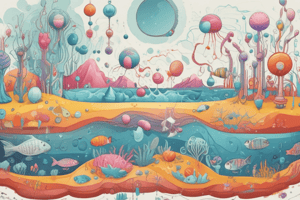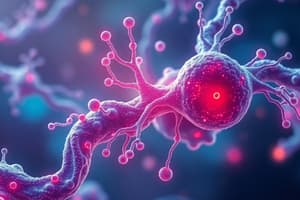Podcast
Questions and Answers
Which enzyme is primarily responsible for carbon fixation during photosynthesis?
Which enzyme is primarily responsible for carbon fixation during photosynthesis?
- Dehydrogenase
- Rubisco (correct)
- Camase
- Flonase
Which of the following statements is NOT a law of thermodynamics?
Which of the following statements is NOT a law of thermodynamics?
- Entropy in the universe increases over time
- Energy cannot be created or destroyed
- The entropy of a substance at absolute zero becomes constant
- All free energy can be recaptured by organisms (correct)
Which situation could influence an enzyme's affinity for its substrate?
Which situation could influence an enzyme's affinity for its substrate?
- Neither
- Both (correct)
- Changed pH
- Changed temperature
In a redox reaction, what type of particles are transferred between atoms or molecules?
In a redox reaction, what type of particles are transferred between atoms or molecules?
The starting point for RNA transcription on a chromosome is referred to as the?
The starting point for RNA transcription on a chromosome is referred to as the?
What are the portions of the mRNA transcript that are retained after splicing called?
What are the portions of the mRNA transcript that are retained after splicing called?
MRNA vaccine technology started to develop a few decades ago in response to which context?
MRNA vaccine technology started to develop a few decades ago in response to which context?
Which mechanism can lead to the development of antibiotic resistance in microbes?
Which mechanism can lead to the development of antibiotic resistance in microbes?
Why do human beings require oxygen from a metabolic perspective?
Why do human beings require oxygen from a metabolic perspective?
What are the observable traits of an organism known as?
What are the observable traits of an organism known as?
What is the primary reason plants release O2 into the atmosphere?
What is the primary reason plants release O2 into the atmosphere?
Which type of mutation results in the substitution of one amino acid for another?
Which type of mutation results in the substitution of one amino acid for another?
What does a p-value of 0.02 indicate regarding the null hypothesis in a t-test?
What does a p-value of 0.02 indicate regarding the null hypothesis in a t-test?
What describes two homologous chromosomes?
What describes two homologous chromosomes?
Which characteristic do viruses share with living organisms?
Which characteristic do viruses share with living organisms?
Which term refers specifically to traits dictated by genetic inheritance?
Which term refers specifically to traits dictated by genetic inheritance?
An amino acid needed in the diet is known as what?
An amino acid needed in the diet is known as what?
The temperature of an ecosystem is categorized as which type of factor?
The temperature of an ecosystem is categorized as which type of factor?
What is the main consequence of mutations in checkpoint protein genes?
What is the main consequence of mutations in checkpoint protein genes?
Which color of visible light can chlorophyll NOT absorb?
Which color of visible light can chlorophyll NOT absorb?
In a Punnett square involving a heterozygous Blood type B individual and a type O individual, what is the likelihood of having a type A child?
In a Punnett square involving a heterozygous Blood type B individual and a type O individual, what is the likelihood of having a type A child?
What is one potential application of recombinant organisms?
What is one potential application of recombinant organisms?
Bacterial cells are primarily classified as what?
Bacterial cells are primarily classified as what?
Freshwater stream water compared to a typical animal cell is classified as what?
Freshwater stream water compared to a typical animal cell is classified as what?
What does it mean when genetic material is described as transmissible?
What does it mean when genetic material is described as transmissible?
If two black mice, exhibiting incomplete dominance for fur color, are bred, what is the probability of producing gray offspring?
If two black mice, exhibiting incomplete dominance for fur color, are bred, what is the probability of producing gray offspring?
In osmosis, water moves from areas of _______ solute concentration to areas of _______ solute concentration.
In osmosis, water moves from areas of _______ solute concentration to areas of _______ solute concentration.
What commonly influences the variation in genetic material within a population?
What commonly influences the variation in genetic material within a population?
Which term best describes the evolutionary relationship of two species in the same family but different genus?
Which term best describes the evolutionary relationship of two species in the same family but different genus?
Which of the following is NOT a characteristic of living things?
Which of the following is NOT a characteristic of living things?
Flashcards
Messenger RNA (mRNA)
Messenger RNA (mRNA)
A type of RNA molecule that carries genetic information from DNA to ribosomes, where proteins are synthesized.
DNA
DNA
A double-stranded nucleic acid that contains the genetic instructions for the development and functioning of all living organisms.
Polypeptide Chain
Polypeptide Chain
A linear chain of amino acids linked together by peptide bonds, forming the basic structure of proteins.
Transmissible Genetic Material
Transmissible Genetic Material
Signup and view all the flashcards
Variation in Genetic Material
Variation in Genetic Material
Signup and view all the flashcards
mRNA Vaccine
mRNA Vaccine
Signup and view all the flashcards
Recombinant Organism
Recombinant Organism
Signup and view all the flashcards
Phenotype
Phenotype
Signup and view all the flashcards
Missense Mutation
Missense Mutation
Signup and view all the flashcards
Heritable Trait
Heritable Trait
Signup and view all the flashcards
Active Transport
Active Transport
Signup and view all the flashcards
Endosymbiotic Theory
Endosymbiotic Theory
Signup and view all the flashcards
Cell Theory Components
Cell Theory Components
Signup and view all the flashcards
Antibiotic Resistance
Antibiotic Resistance
Signup and view all the flashcards
Rubisco
Rubisco
Signup and view all the flashcards
First Law of Thermodynamics
First Law of Thermodynamics
Signup and view all the flashcards
Impact on Enzyme Affinity
Impact on Enzyme Affinity
Signup and view all the flashcards
Redox Reaction
Redox Reaction
Signup and view all the flashcards
Human Need for Oxygen
Human Need for Oxygen
Signup and view all the flashcards
Plant Oxygen Release
Plant Oxygen Release
Signup and view all the flashcards
P-value in Hypothesis Testing
P-value in Hypothesis Testing
Signup and view all the flashcards
Viruses - Living or Non-living?
Viruses - Living or Non-living?
Signup and view all the flashcards
Essential Amino Acids
Essential Amino Acids
Signup and view all the flashcards
Abiotic Factor
Abiotic Factor
Signup and view all the flashcards
DNA vs. RNA: Three Differences
DNA vs. RNA: Three Differences
Signup and view all the flashcards
Evolutionary Relatedness
Evolutionary Relatedness
Signup and view all the flashcards
Polar Molecules and Hydrogen Bonding
Polar Molecules and Hydrogen Bonding
Signup and view all the flashcards
Scientific Theory
Scientific Theory
Signup and view all the flashcards
Chlorophyll and Light Absorption
Chlorophyll and Light Absorption
Signup and view all the flashcards
Prokaryotic Cells
Prokaryotic Cells
Signup and view all the flashcards
Study Notes
BIO 110: Final Exam Format
- The exam is divided into five sections, each representing a course unit.
- Each section contains four multiple-choice questions (2 points each) and four short-answer questions (4 points each).
- Answer all multiple-choice questions.
- Skip one short-answer question per section.
- Each section is worth 20 points.
- The entire exam is worth 100 points.
Section 1: Principles of Life and Properties of Biomolecules
- Question 1: A p-value of 0.02 in a t-test indicates rejection of the null hypothesis.
- Question 2: Viruses possess the characteristic of energy use and metabolism.
- Question 3: Essential amino acids must be consumed through diet.
- Question 4: Temperature is an abiotic factor in ecosystems.
- Question 5: List three differences between DNA and RNA.
- Question 6: Species A and B, sharing the same family but different genus, are more closely related than species C and D (same order & different family), or species E and F (same class & different order).
- Question 7: Polar molecules, like water, engage in hydrogen bonding through partial positive and negative charges on the molecule, influencing physical properties.
Section 2: Principles of Cell Biology
- Question 9: Chlorophyll absorbs all colors except green.
- Question 10: Bacteria are prokaryotic cells.
- Question 11: Fresh water relative to animal cells is hypotonic.
- Question 12: In osmosis, water moves from areas of higher solute concentration to lower solute concentration.
- Question 13: Active transport requires energy to move molecules against a concentration gradient (e.g., from low to high concentration).
Section 3: Metabolism and Photosynthesis
- Question 17: Rubisco is the enzyme responsible for carbon fixation during photosynthesis.
- Question 18: The law of energy conservation is that energy can neither be created nor destroyed.
- Question 19: Changes in pH and temperature can affect enzyme affinity for its substrates.
- Question 20: Electrons are transferred during redox reactions.
- Question 21: Humans require oxygen for cellular respiration (aerobic respiration), a crucial metabolic process that releases energy from glucose.
- Question 22: Plants release oxygen as a byproduct of photosynthesis, driving the reduction of carbon dioxide into glucose.
Section 4: Genetic Processes
- Question 25: RNA transcription starts at the promoter site on a chromosome.
- Question 26: mRNA vaccine technology has been under development for some time, starting decades beforehand.
- Question 27: Exons are the retained parts of a transcript after splicing.
- Question 28: Translation results in polypeptide chains.
- Question 29: Transmissible genetic material means the genetic material can be passed from parent to offspring.
- Question 30: Variation in genetic material within a population is important for adaptation and evolution.
- Question 31: mRNA vaccines introduce mRNA into cells to synthesize target proteins against infection, triggering an immune response, distinct from traditional vaccines that introduce weakened antigens.
Section 5: Genetic Inheritance
- Question 33: Phenotype are the traits that are expressed.
- Question 34: Missense mutations change the amino acid sequence in a protein.
- Question 35: Homologous chromosomes have the same gene sequences but can have different allele expressions.
- Question 36: Heritable traits are those characteristics influenced by genotype factors.
- Question 37: Possible consequences of checkpoint protein mutations could affect cell division control leading to uncontrolled cell growth (tumors).
- Question 38: Recessive alleles are more likely to cause genetic diseases because they can mask expression, requiring two copies of the recessive gene to manifest an effect.
- Question 39, 40: These questions require Punnett squares to predict potential blood type (question 39) and fur color outcomes (question 40) based on parental genotypes and inheritance patterns (in particular incomplete dominance).
Studying That Suits You
Use AI to generate personalized quizzes and flashcards to suit your learning preferences.




